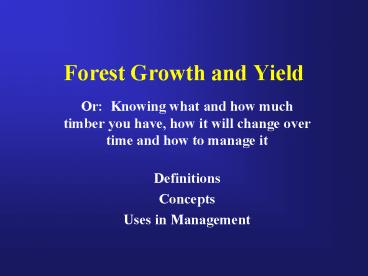Forest Growth and Yield - PowerPoint PPT Presentation
1 / 16
Title:
Forest Growth and Yield
Description:
Site index: a particular measure of site quality based on the average height of ... Must first determine the average basal area and number of trees per acre ... – PowerPoint PPT presentation
Number of Views:904
Avg rating:3.0/5.0
Title: Forest Growth and Yield
1
Forest Growth and Yield
- Or Knowing what and how much timber you have,
how it will change over time and how to manage
it - Definitions
- Concepts
- Uses in Management
2
Forest Growth and YieldDefinitions
- Forest yield the volume of timber in a forest
at a specific point in time - Forest growth the change in volume over an
interval of time
3
Forest Growth and YieldDefinitions
- Site quality a loose term denoting the relative
productivity of a site for a particular tree
species - Site index a particular measure of site quality
based on the average height of the dominant and
codominant trees at a specified index age (25, 50
or 100 years usually 50 years)
4
Site Index Curves for Eastern White Pine
- Height and age used as coordinates to determine
site index - SI correlated with soil factors and topography
- Curves have been developed for most commercial
forest tree species
5
Forest Growth and YieldDensity vs Stocking
- Stand density
- Indicates degree of stem crowding within the
stand - Stocking
- Refers to whether the stand density meets a
particular management objective - These two terms are often interchanged, but they
have different meanings
6
Forest Growth and YieldDensity vs Stocking
- Stocking chart
- Shows acceptable ranges of basal area for stands
of different average diameters - Must first determine the average basal area and
number of trees per acre - Use these as coordinates on chart
- If point falls between curves on stocking chart,
stand is fully stocked - Point below curve means stand is understocked
above curve means stand is overstocked
Stocking chart for managed red pine
7
Forest Growth and Yield
- Note
- Height growth is affected by site quality (and
genetic value) but not much by stand density
(except at extremes) - Basal area is affected by stand density but not
well-correlated with site quality (except at
extremes)
8
Yield Tables
- Future yields and stand conditions can be
predicted using growth models and yield tables - Some models allow for treatments such as thinning
9
Forest Management
- Regulated forest
- Sustained yield
- Allowable cut
10
Regulated forest and sustained yield
- A forest that produces a continuous flow of
products of about the same size, quality and
quantity over time is called a regulated forest - Sustained yield refers to the continuous flow of
timber products - Regulated forests, by definition, provide
sustained yield - The larger the ownership, the easier it is to
attain a sustained yield
11
Regulated Forest -Even-aged example
- Assumptions
- 25 years to maturity
- 25-acre forest
- all acres of equal productivity
- Managed as 25 individual even-aged stands - one
stand harvested each year - In practice, usually not as simple as example
12
Regulated forest - Uneven-aged example
- Assumptions
- Trees mature at some regular interval (4 years in
example) - Need 4 stands to be able to harvest something
each year
13
Rotation vs cutting cycle
- Rotation age and cutting cycle are both used to
designate when stands are cut. Note the
difference between them. - Rotation age The length of time from final
harvest cut to final harvest cut in even-aged
management - Cutting cycle The length of time between major
cuts (harvest entries) in uneven-aged management
14
Allowable cut
- The amount of timber considered available for
cutting during a specified time period, usually
one year
15
Rotation ageEven-aged management
- Rotation age is determined by first identifying
the landowners objective - Is the period of years required to establish and
grow timber crops to a specific condition of
maturity (or value) refers to even-aged
management only
16
Cutting cycleUneven-aged Management
- Idea is to cut a volume of timber equal to the
growth - Example shows 5-year cycle
- The forest is regulated by manipulating the
stands so that an equal volume of timber is due
for cutting each year - Concept is equivalent to living off interest
from money deposited in a savings account at the
bank
Reserve growing stock
Cutting cycle for a single stand
Cutting cycle for a regulated, uneven-aged forest

